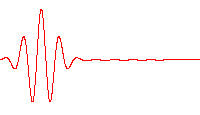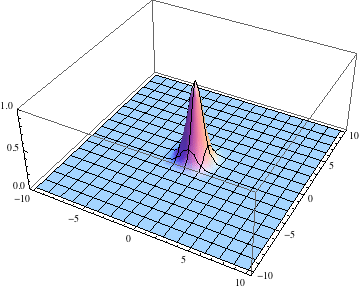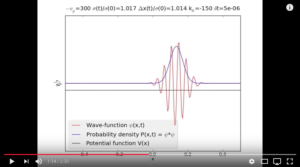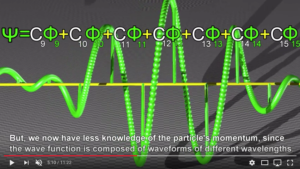So, here’s the thing. If I roll with Quantum Field Theory (QFT), how do I reconcile my macroscopic and microscopic views of things. Simple things. Like looking at a tiny candle across the room?
“P vision”
Imagine if we could see individual photons (without being overwhelmed by visual “noise” in very low light). Where might that take us? Historically quicker to the physics of quanta — quantum mechanics (QM)? To waves, fluctuations in fields? To the “probabilistic nature of quantum mechanical phenomena?”
At least, we could look closer. We might see light as a “blizzard” of microscopic bits of energy shooting at us, and study how biology smooths that in everyday experience, eh.
“W vision” — looking closely enough?
Wiki: “Quantum mechanics ascribes a special significance to the wave packet; it is interpreted as a probability amplitude, its norm squared describing the probability density that a particle or particles in a particular state will be measured to have a given position or momentum. The wave equation is in this case the Schrödinger equation.” (Note the “A wave packet without dispersion (real or imaginary part)” animation in this article.)
I’m exploring 2D/3D visualizations of the Schrödinger equation for a “photon” moving through space-time.1 The Wiki article for the Schrödinger equation has this animated GIF.

What kind of vision might get us to perceiving light as waves? Physics lab. The double slit. We see that light exhibits interference.
But how does a quantum field fluctuation move as a linear propagation from a source — a light ray in “P vision?” Does interference play any role? Is there “dampening” of vibrations outside the “main lobe” of the field fluctuation?
Time to put on the “Q vision” goggles.
“Q vision”
Virtual reality goggles? A simulation, eh. That’s what I’m trying to understand. The math is complex. And then there’re the various interpretations of QM. Carroll says, “I think Copenhagen is completely ill-defined, and shouldn’t be the favorite anything of any thoughtful person. … I put it this way: here in 2013, we don’t really know whether objective ‘wave function collapse’ is part of reality … We also don’t know whether, for example, supersymmetry is part of reality. … All we have to do is wrap our brains around the issue, and yet we’ve failed to do so.”
However, other people might say that this is just the way Carroll’s concept of emergence works, namely, compatible (but different) “ways of talking that describe the same underlying world” for the same (or similar) domain of applicability. Will some future experiment decide the issue?
“… many microscopic theories can lead to the same emergent behavior.” — Carroll, Sean (2016-05-10). The Big Picture: On the Origins of Life, Meaning, and the Universe Itself (p. 106). Penguin Publishing Group. Kindle Edition.
“B vision”
My takeaway is that we really don’t understand the degree to which biological processes are grounded in quantum mechanics. The long journey of evolution, from primitive cells to complex organisms which sense and interact with the environment. We have grown out of the world. Biological processes at the molecular level grew out of the world. Things which we hardly understand as yet. Quantum biology is a young field.
Update (December 2017): This humorous YouTube video “What the HECK is a Photon?!” by The Science Asylum (published on Dec 19, 2017) explores photon properties and beyond frog vision.
A photon is a purely quantum mechanical object representing the smallest piece of energy (or quanta) for light. Every quantum particle is a packet of energy though, so how do we tell photons apart from electrons, quarks, and neutrinos?
[1] Visualizations perhaps like those on this Mathematica Stack Exchange page: “Complex valued 2+1D PDE Schrödinger equation, numerical method for `NDSolve`?” for the free particle propagation of an initial wave packet.
Below I show the original problem of a Gaussian wave packet with no initial momentum, and then a modified case where an initial momentum has been imparted, making the initial condition complex as well. I call the complex wave function ψ and plot its absolute value … The above numerical solutions are basically for a free particle, except that the spatial grid is forcing us to choose some boundary conditions on the sides of the square. Periodic boundary conditions are a common choice. But the whole effort is overkill for a free particle because the solutions can be obtained analytically.

Or this “Animating Schrödinger’s Equation” YouTube video (you may want to mute the audio) for traveling wave packets (“…. a normal Gaussian distribution with standard deviation in particle position”). There’s a list of software used at the end of the presentation. I like the overlay of the wave-function, probability density, and potential function.
Published on May 25, 2012
2m30s fly-through of the powerpoint slides and videos used in my final year undergraduate physics project presentation; Animating Schrödinger’s Equation, one dimensional quantum wave mechanics in action, set to some dramatic music … Analogous to a method of modeling time-development of classical waves on a one dimensional string using Fourier components. … An eigenvalue problem. … Time-dependent problem: the harmonic oscillator … the first 32 eigenstates were used to reconstruct an initial electron wave packet.

Or this professional “Quantum Wave Function Visualization” video, also on YouTube.
Published on Feb 13, 2016
Superposition, wave function collapse, and uncertainty principle in Quantum Physics. Shows real & imaginary components of quantum wave functions for free particles and confined particles.


Above I wrote:
Well, this phys.org article “Spotting nature’s own evolution of quantum tricks could transform quantum technology” (November 22, 2018, University of Warwick), highlights some research in quantum biology.
Speaking of frog vision, this Wired article discusses how the narrow spectrum of visible light does not apply to many amphibians.
Wired > “So, Amphibians Glow. Humans Just Couldn’t See It—Until Now” – Bathe an amphibian in blue light and it glows a brilliant green. But what does this all mean? – by Matt Simon (February 27, 2020).